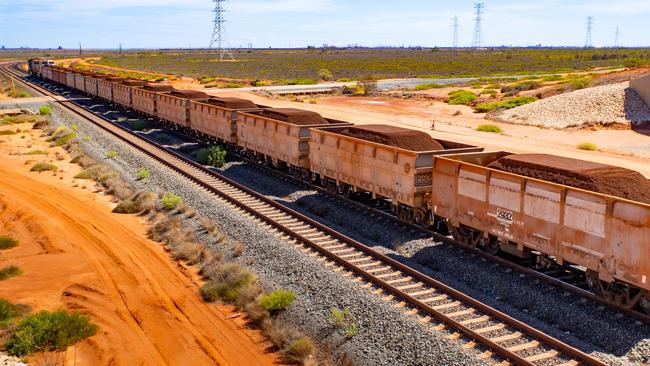Iron ore slide a hiccup for big miners amid copper scramble
The iron ore price has tumbled, hitting the world’s biggest miners as they look to increase their exposure to copper and other metals.

The price of iron ore has fallen to its lowest level in nearly two years, a drain on profits for some of the world’s biggest miners as they raise bets on commodities such as copper that they expect will be essential to the energy transition.
Iron ore, used to make steel, is one of the worst-performing mined commodities this year, hit hard by the crisis in China’s property market as far fewer homes start construction.
The benchmark price for iron ore is down by as much as 36 per cent so far this year. It traded as low as $US90 a tonne this week, the lowest price recorded since November 2022, according to S&P Global Commodity Insights, which assesses iron ore prices. The price edged a tad higher on Wednesday.
Several of the world’s biggest miners rely on the commodity for a big chunk of their profits. For BHP, the world’s most valuable miner, iron ore contributed 64 per cent of earnings in the year to June 30. Rio Tinto, the second-biggest miner by value, relies on iron ore for almost seven of every 10 dollars it earns.
Those companies have much lower mining costs than smaller rivals, meaning their mammoth iron ore operations continue to be lucrative even at reduced prices. They may not be as big a moneymaker in the future as they have been in the recent past, though.
The downturn is a hit to corporate war chests at a time when miners, after years of holding back on big investments, are increasing spending on projects and acquisitions in copper and some other commodities, including lithium. Those commodities are expected to experience a sharp rise in demand as more money pours into renewable energy, electric vehicles and power grids.
The mining industry needs to consistently finance and build new copper projects at a rate that was only achieved for a few years at the end of the China-led commodities boom if the world is to meet a goal of limiting the rise in temperatures to close to 1.5C, commodities consulting firm Wood Mackenzie has said.
Of the commodities that miners dig up, iron ore is one of the most vulnerable to a slowdown in China, which buys seven in every 10 tonnes of iron ore shipped globally. Its property sector is a top source of steel demand.
Chinese housing data suggests that the sector is in bad shape, despite the government stepping up support for it and other industries in recent months. As a result, many steel mills there are losing money on their sales.
“China’s steel industry has raised alarm about how tough conditions can become,” ING analyst Ewa Manthey said. In August, steel giant China Baowu Steel cautioned that the situation facing the steel sector was more dire than prior downturns this century, and that the slump was likely to be longer and more difficult than previously expected.
A 5 per cent fall in China’s iron ore imports in August from a year earlier is the first annual contraction since November 2022 and reflects the subdued state of steel demand in China, Commonwealth Bank of Australia analyst Vivek Dhar said.
Iron ore has been piling up at the country’s ports, with stockpiles stored at major Chinese port facilities up by roughly 30 per cent in the year to date.
Analysts are divided over what could happen to prices next.
Some reckon iron ore prices are likely to remain under pressure, citing the losses at Chinese steel mills and build-up in port stockpiles. ING’s Ms Manthey expects the price to average $US95 in the final quarter of the year.
Others argue mining costs should stop prices from falling much further and that the commodity could enjoy a bounce as iron ore supply growth slows and steel mills restock raw materials following the summer, as they typically do. CBA’s Mr Dhar forecasts iron ore will trade between $US100 and $US110 a tonne in the fourth quarter.
Economists at BHP last month said the market was experiencing a deepening glut and they expected supplies would continue to outpace demand into next year.
Still, they estimated mining costs could put a floor under prices somewhere in the range of $US80-$US100 a tonne. The thinking is that dips below that level would cause high-cost producers to stop mining, helping to rebalance supply and demand.
BHP chief executive Mike Henry pointed to the company’s margins as reassurance the miner could ride out volatility in prices. The miner recorded a margin of 68 per cent for its iron ore business last fiscal year.
Still, investors worry the big miners’ iron ore businesses are so huge that there’s little they can do to counter a sharp fall in prices.
“Right now, there’s real pain in [the] iron ore world,” Panmure Liberum analyst Tom Price said in a note. On the near-term outlook, Mr Price is in the bear camp.
“Already down 30-40 per cent YTD, is there any upside for ore prices? Not yet,” he said.
Shares in BHP and Rio Tinto are down by roughly 20 per cent year to date.


